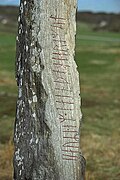Runestone by Nedre Hoga
The rune stone of Nedre Hoga (also rune stone of Hoga ; Swedish Hogastenen or Ramunds Häll) is in Stala socken on the island of Orust in Bohuslän in Sweden .
The slender and pointed rune stone made of gneiss, about three meters high . Orust's only rune stone is dated to 800 AD; the change between the Vendel and the Viking Age . Tradition has it that it comes from the Iron Age burial ground further up in the valley . It was erected here at the end of the 19th century. It is mentioned as early as 1643 when it was still lying on the ground. large, narrow stone stands on a burial ground with cathedral rings made of seven and nine large stones.
The runic inscription consists of 22 characters in a row, which makes it difficult to interpret. There are different theories about the meaning of the text. One is: Ior i Åm utförde stenen här på mulen (Ior from Åm built the stone here on the hill). In the tradition the stone is called "Ramund's rock".
Surroundings
Up in the valley, around 25 graves form a 190 by 60 m grave field from the Iron Age. It consists of eight loops , the largest of which is 14 m in diameter, and 17 round stone settings. The stones are overgrown by grass and only partially visible. There are two rings of judges from the late Iron Age (around 500 AD) that are so close together that they touch at one point. The southern ring consisted of seven stones, the northern one of nine stones. Some stones are missing or have fallen over.
- Hostesses
Web links
- Runestone by Nedre Hoga - entry in the database "Fornsök" des Riksantikvarieämbetet (Swedish)
- Description and picture
Coordinates: 58 ° 9 ′ 33 " N , 11 ° 41 ′ 56.3" E




